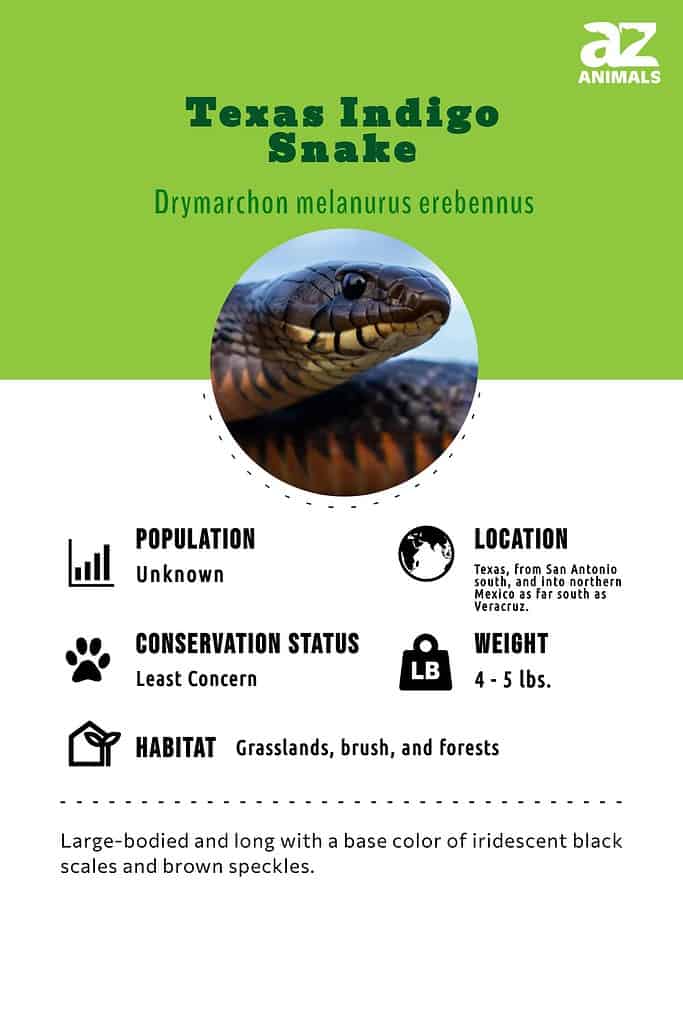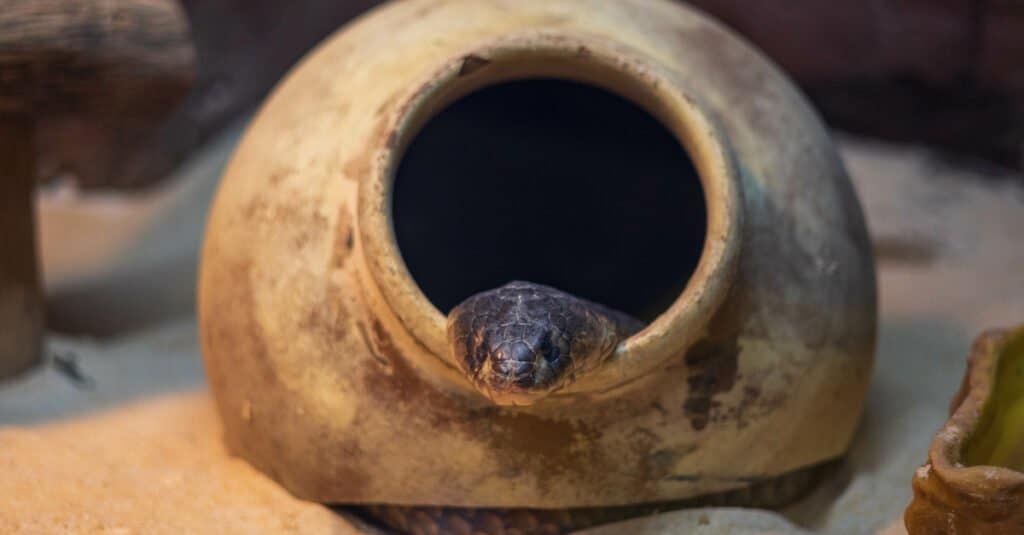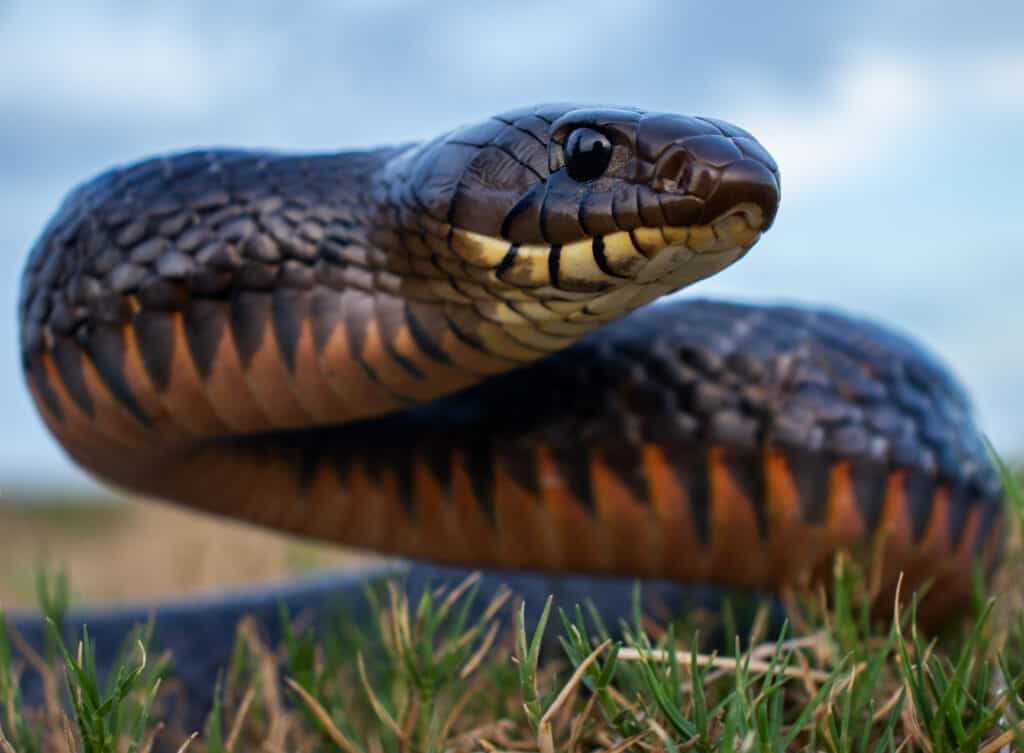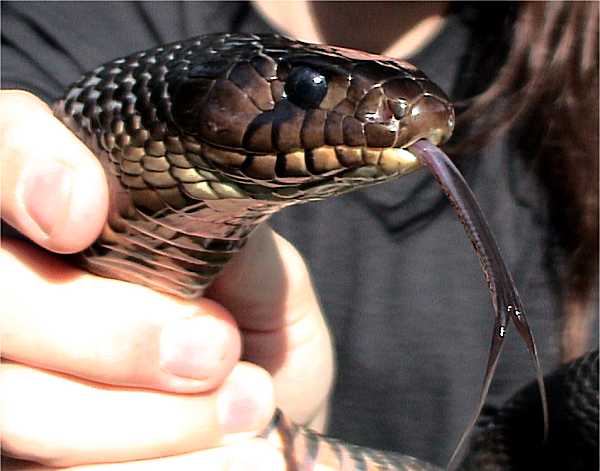Texas Indigo Snake
Drymarchon melanurus erebennus
Texas Indigo Snakes are known for chasing down, overpowering, and eating rattlesnakes.
Advertisement
Texas Indigo Snake Scientific Classification
- Kingdom
- Animalia
- Phylum
- Chordata
- Class
- Reptilia
- Order
- Squamata
- Family
- Colubridae
- Genus
- Drymarchon
- Scientific Name
- Drymarchon melanurus erebennus
Read our Complete Guide to Classification of Animals.
Texas Indigo Snake Conservation Status
Texas Indigo Snake Facts
- Prey
- snakes, small mammals, lizards, birds
- Main Prey
- All native venomous snakes
- Name Of Young
- Hatchlings
- Group Behavior
- Solitary
- Fun Fact
- Texas Indigo Snakes are known for chasing down, overpowering, and eating rattlesnakes.
- Biggest Threat
- Birds of Prey, Human encroachment
- Most Distinctive Feature
- Iridescent blueish sheen in the light.
- Other Name(s)
- Texas blue indigo, blue indigo snake, indigo snake
- Temperament
- Mostly docile unless harassed
- Litter Size
- 3-12
- Habitat
- Grasslands, brush, forests in Texas, from San Antonio south, and into northern Mexico as far south as Veracruz.
- Diet for this Fish
- Carnivore
- Lifestyle
- Diurnal
- terrestrial
- Common Name
- Texas Indigo Snake
Texas Indigo Snake Physical Characteristics
- Color
- Brown
- Black
- Black-Brown
- Skin Type
- Scales
- Lifespan
- Estimated at 15
- Age of Sexual Maturity
- 2-3 years
View all of the Texas Indigo Snake images!
“If it’s a Texas Indigo snake, let it go,” is a popular adage among Texas ranchers and farmers.
They’re very popular in southern/central Texas where they primarily live. Texas indigo snakes are known for actively hunting and eating rattlesnakes. Diurnal by nature, they spend their nights in the burrows that other animals abandon.
These snakes mate in the winter and then lay eggs in an abandoned burrow in the spring. They lay 3-12 eggs, and hatchlings appear in the summer and measure 14-18 inches, but can reach 24 inches. They’re one of the longest species in North America and regularly reach 6-8 feet long; there have been reports of snakes approaching 10 feet, but they haven’t been verified.
They range from central Texas extending into northern Mexico, and until recently Texas indigo snakes were on the protected list in Texas.

Amazing Facts About Texas Indigo Snakes
- They appear to be at least partly resistant to rattlesnake venom.
- Terrific to have around if you have venomous snakes nearby.
- They’ll eat anything they can overpower; birds, lizards, turtles, snakes, and rodents are all on their varied menu.
- They subdue their prey using brute force but are surprisingly docile.
Where To Find Them

Texas indigo snakes are native to Texas, but their range extends into northern Mexico.
©Joe Farah/Shutterstock.com
These snakes inhabit areas with permanent water sources and grasslands, brush, or forests in Texas south of San Antonio, and into northern Mexico, as far as Veracruz.
They spend their downtime in abandoned burrows and underneath logs and other items large enough to hide them, but Texas indigo snakes are active hunters and spend most of their time hunting during the day.
Scientific Name

The Texas Indigo Snake’s scientific name is Drymarchon melanurus erebennus.
©Wirestock Creators/Shutterstock.com
Texas indigo snakes (Drymarchon melanurus erebennus) are part of the Colubridae family along with kingsnakes and boa constrictors. However, they are not constrictors. Their scientific name, Drymarchon, roughly translates as “Lord of the Forest,” melanurus is Greek and means black.
All of the indigo snake species have smooth, very shiny scales that reflect an iridescent blue-purple in the light, giving them their common name.
Types of Indigo Snakes
Until recently, all indigo snakes were classified as subspecies of Drymarchon corais, even some of the government sites still reflect this. However, genetic research revealed that there are five separate species; given more time and research we may discover more.
Two of them occur in North America:
- D. melanurus erebennus mainly lives in south Texas and northern Mexico. It is primarily black but has some brown speckling.
- D. couperi Eastern indigo snakes live in the southeastern United States.
Two indigo snake species inhabit Central and South America:
- D. caudomaculatus lives in Venezuela and Colombia and has more brown speckling than its northern cousins
- D. margaritae inhabits the Western Margarita Islands and Venezuela.
History and Evolution
Like other snake species, the Texas Indigo Snake’s predecessors were also reptiles but they had legs. These animals were more aquatic-based. Snakes either lost their legs or became vestigial, as snakes relied on them less and less. It is interesting to imagine animals evolving to have legs and then evolving to lose them! As these snakes adapted to living as low to the ground as they could to avoid enemies and be closer to their prey.
These particular snakes adapted to being very good at killing other snakes and other smaller animals. In the wild, competition from other species leads to a few different outcomes over a long period of time. Extinction happens when an animal species is not able to adapt and overcome said competition. In this snake’s case, the outcome was to become stronger than other snakes in its area and even develop resistance to their venom.
Population & Conservation Status

It’s against the law to collect Texas Indigo Snakes in the wild without a permit, but they are no longer on the protected list in Texas.
©Joe Farah/Shutterstock.com
For such a popular and well-loved snake, there’s a surprising lack of formal research into their population numbers, and stability and lifespan in the wild. We don’t have an accurate population estimate, and we can guess that in the wild they might live about 9 years. It’s against the law to collect these snakes in the wild without a permit, but they are no longer on the protected list in Texas, and they are not on the IUCN Redlist.
However, Texas indigo snakes still face challenges due to human encroachment. Each individual needs a large territory in which to thrive but is fairly flexible as long as there is a permanent water source nearby. They tend to favor somewhat dry grasslands and scrub brush. However, urban sprawl is reducing the amount of territory available and many indigo snakes end up on the road, victims of a vehicle encounter.
Appearance and Description

Texas indigo snakes are large-bodied, very long snakes with a base color of iridescent black scales and brown speckles.
©Radiant Reptilia/Shutterstock.com
Texas indigo snakes are large-bodied, very long nonvenomous snakes with a base color of iridescent black scales and brown speckles. Their belly is often salmon-colored, becoming more cream-colored approaching the throat, and more blue-black towards the tail. They have black vertical bars that begin under their eyes and extend down to their labial (lip) scales. In fact, seeing dark vertical bars along the lip scales is one sign that a North American snake is not venomous, although this doesn’t hold true on other continents.
Hatchlings appear in the summer and can reach 2 feet long; there have been sightings of Texas indigo snakes nearly 10 feet long, but they’re not verified. Juveniles are often solid black but develop adult colors as they mature between the ages of 2-3.
How Dangerous Are They?
These snakes are generally docile and not aggressive; they’re kept as pets by many people for this reason and for their beauty. However, those who handle or harass a Texas indigo snake may discover its powerful bite. It may also release a foul-smelling musk from its cloaca and even rattle its tail.
Texas Indigo Snakes are well known as rattlesnake control and loved by Texas farmers and ranchers. They are not aggressive, and as a result, are easy to observe from a respectful distance. There are multiple videos available that demonstrate their prowess as rattlesnake hunters; in a few of them, you can see the rattlesnake biting (and probably envenomating) the Texas indigo snake but still losing the battle.
Behavior & Humans

Texas Indigo Snakes are popular pets because of their beauty and their easy-going attitude.
©Photographer: LA Dawson, animals courtesy of Austin Reptile Service. – Original / License
Texas indigo snakes are supremely helpful and feed on many of the animals that humans find a nuisance or, in the case of venomous snakes, dangerous. However, they need a large territory in which to hunt and they are frequently run over by vehicles when crossing the road.
A Texas indigo snake will eat nearly anything it can overpower using its size and strength; in addition to venomous snakes, its menu includes non-venomous snakes such as coachwhips, small mammals, lizards, turtles, and birds. They’re really not all that picky. According to an article in the Naples News, “One specimen alone had three mice, two Mexican burrowing toads, and two juvenile snapping turtles in its stomach contents.”
These snakes were respected in southern Texas as rodent and rattlesnake control. So much so that many families kept them as pets around the yard to keep rodents and venomous snakes away. Even now, they’re popular pets because of their beauty and their easy-going attitude.
Similar Animals
View all 133 animals that start with TTexas Indigo Snake FAQs (Frequently Asked Questions)
Are Texas indigo snakes venomous?
No, they’re not. However, they do have a strong bite and it’ll hurt if one gets upset enough to bite.
How do Texas indigo snakes hunt?
Indigo snakes are active daytime hunters. They generally flush out prey then chase it down to overpower it. They use their physical mass and strength to hold it down against a hard surface to subdue it.
Are Texas indigo snakes aggressive?
Not typically, but they’ll bite to defend themselves using their strong jaws or by releasing a stinky musk from their cloaca.
Where do Texas indigo snakes live?
Their range includes southern Texas and northern Mexico in grasslands and forested areas near a permanent water source.
What do Texas indigo snakes eat?
Texas indigo snakes will eat any animal they can overpower. Their favorite food seems to be any venomous snakes native to their range. They are big and powerful and use brute force to subdue their prey. Using their strong jaws, they hold it by the head and often push their prey against a hard surface (ground, rock, etc). One Texas indigo snake found by researchers had 2 mice, 2 juvenile turtles, and a bird in its stomach.
Thank you for reading! Have some feedback for us? Contact the AZ Animals editorial team.
Sources
- Reptile Database / Accessed February 16, 2022
- Southwest Center for Herpetological Research / Accessed February 16, 2022
- Texas Parks & Wildlife / Accessed February 17, 2022
- IUCN Redlist / Accessed February 17, 2022


















